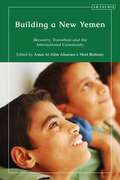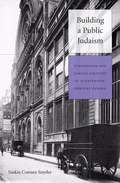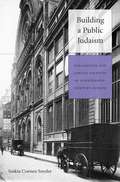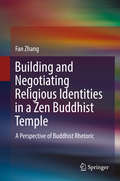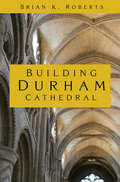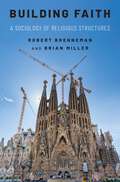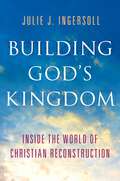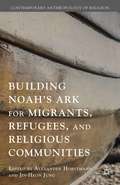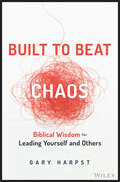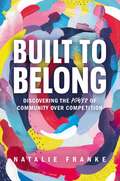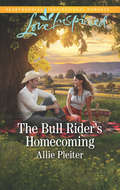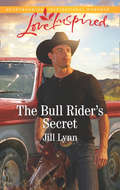- Table View
- List View
Building a Healthy Multi-ethnic Church: Mandate, Commitments and Practices of a Diverse Congregation (Jossey-Bass Leadership Network Series #22)
by Mark DeYmazThrough personal stories, proven experience and a thorough analysis of the biblical text, Building a Healthy Multi-ethnic Church illustrates both the biblical mandate for the multi-ethnic church as well as the seven core commitments required to bring it about. Mark DeYmaz, pastor of one of the most proven multi-ethnic churches in the country, writes both from his experience and his extensive study of how to plant, grow, and encourage more ethnically diverse churches. He argues that the "homogenous unit principle" will soon become irrelevant and that the most effective way to spread the Gospel in an increasingly diverse world is through strong and vital multi-ethnic churches.
Building a New Yemen: Recovery, Transition and the International Community
by Amat Al Alim Alsoswa and Noel BrehonyYemen has faced continuing crises since 2010. The fighting and divisions have destroyed much of Yemen's physical, political and social infrastructure, undermining its tribal traditions and religious tolerance, and impoverishing the country. The outbreak of war in 2015 caused the world's worst humanitarian crisis. In this book, Yemeni and international experts assess what political arrangements are required to overcome fragmentation and discord in Yemen. They look to understand how people from all parts of the county can work together to build a new Yemen, one that will give a voice to its young population and provide a full role for women. The contributors argue that Yemen's major resource is its population, but that Yemenis need to be motivated and trained to give them the skills to rebuild the economy and to prepare for long-term challenges such as water shortages and climate change. The volume also discusses how the international community will need to absorb the lessons of the past to find better ways of creating the institutions, mechanisms and transparency with Yemenis that will enable the flow of vital assistance to where it is most needed.The book provides an up-to-date analysis to help governments and international agencies who will have to work with Yemen and its neighbours in the post conflict situation.
Building a New Yemen: Recovery, Transition and the International Community
Yemen has faced continuing crises since 2010. The fighting and divisions have destroyed much of Yemen's physical, political and social infrastructure, undermining its tribal traditions and religious tolerance, and impoverishing the country. The outbreak of war in 2015 caused the world's worst humanitarian crisis. In this book, Yemeni and international experts assess what political arrangements are required to overcome fragmentation and discord in Yemen. They look to understand how people from all parts of the county can work together to build a new Yemen, one that will give a voice to its young population and provide a full role for women. The contributors argue that Yemen's major resource is its population, but that Yemenis need to be motivated and trained to give them the skills to rebuild the economy and to prepare for long-term challenges such as water shortages and climate change. The volume also discusses how the international community will need to absorb the lessons of the past to find better ways of creating the institutions, mechanisms and transparency with Yemenis that will enable the flow of vital assistance to where it is most needed.The book provides an up-to-date analysis to help governments and international agencies who will have to work with Yemen and its neighbours in the post conflict situation.
Building a Perfect Match (Chatam House #6)
by Arlene JamesTHE RIGHT MAN FOR THE JOB? In charge of a hotel renovation, Petra Chatam’s got everything under control—except Dale Bowen. The too-handsome contractor has his own ideas about the project. And they don’t match up with ambitious Petra’s, who hopes to become hotel manager.
Building a Public Judaism: Synagogues And Jewish Identity In Nineteenth-century Europe
by Saskia Coenen SnyderCoenen Snyder considers what the architecture and construction of nineteenth-century European synagogues reveal about the social progress of modern European Jews. The process of claiming a Jewish space was a marker of acculturation but not full acceptance, she argues. The new edifices, even if spectacular, revealed the limits of Jewish integration.
Building a Public Judaism: Synagogues And Jewish Identity In Nineteenth-century Europe
by Saskia Coenen SnyderCoenen Snyder considers what the architecture and construction of nineteenth-century European synagogues reveal about the social progress of modern European Jews. The process of claiming a Jewish space was a marker of acculturation but not full acceptance, she argues. The new edifices, even if spectacular, revealed the limits of Jewish integration.
Building and Negotiating Religious Identities in a Zen Buddhist Temple: A Perspective of Buddhist Rhetoric
by Fan ZhangThis book explores the practices in a Zen Buddhist temple located in Northwest Ohio against the backdrop of globalization. Drawing on the previous studies on Buddhist modernization and westernization, it provides a better understanding of the westernization of Buddhism and its adapted practices and rituals in the host culture. Using rhetorical criticism methodology, the author approaches this temple as an embodiment of Buddhist rhetoric with both discursive and non-discursive expressions within the discourses of modernity. By analyzing the rhetorical practices at the temple through abbots’ teaching videos, the temple website, members’ dharma names, and the materiality of the temple space and artifacts, the author discovers how Buddhist rhetoric functions to constitute and negotiate the religious identities of the community members through its various rituals and activities. At the same time, the author examines how the temple’s space and settings facilitate the collective the formation and preservation of the Buddhist identity. Through a nuanced discussion of Buddhist rhetoric, this book illuminates a new rhetorical methodology to understand religious identity construction. Furthermore, it offers deeper insights into the future development of modern Buddhism, which are also applicable to Buddhist practitioners and other major world religions.
Building Durham Cathedral
by Brian K. RobertsDurham Cathedral was completed nearly 900 years ago, after 40 years of construction. Inevitably it has suffered from the effects of time: physical erosion, from the weather and increasing pollution on stone that was never of the best quality, and cultural erosion, the impact of secular and religious changes – not least the depredations of clerics, improvers, and administrators. Nevertheless, it remains: the stones speak and provide the story of themselves. Building Durham Cathedral explores this magnificent structure by questioning its architectural plans and stonework. As there have been minimal additions we catch sight of it as the Norman builders intended. Remarkably, a few early documents and the stonework itself allow us to glimpse its beginnings and some of the personalities involved. Questions remain, but there may even be a clue to the identity of its original master mason.
Building Faith: A Sociology of Religious Structures
by Robert Brenneman Brian J. MillerThe social sciences have mostly ignored the role of physical buildings in shaping the social fabric of communities and groups. Although the emerging field of the sociology of architecture has started to pay attention to physical structures, Brenneman and Miller are the first to combine the light of sociological theory and the empirical method in order to understand the impact of physical structures on religious groups that build, transform, and maintain them. Religious buildings not only reflect the groups that build them or use them; these physical structures actually shape and change those who gather and worship there. Religious buildings are all around us. From Wall Street to Main Street, from sublime and historic cathedrals to humble converted storefronts, these buildings shape the global religious landscape, "building faith" among those who worship in them while providing a testament to the shape and duration of the faith of those who built them and those who maintain them. Building Faith explores the social impact of religious buildings in places as diverse as a Chicago suburb and a Guatemalan indigenous Mayan village, all the while asking the questions, "How does space shape community?" and "How do communities shape the spaces that speak for them?"
Building Faith: A Sociology of Religious Structures
by Robert Brenneman Brian J. MillerThe social sciences have mostly ignored the role of physical buildings in shaping the social fabric of communities and groups. Although the emerging field of the sociology of architecture has started to pay attention to physical structures, Brenneman and Miller are the first to combine the light of sociological theory and the empirical method in order to understand the impact of physical structures on religious groups that build, transform, and maintain them. Religious buildings not only reflect the groups that build them or use them; these physical structures actually shape and change those who gather and worship there. Religious buildings are all around us. From Wall Street to Main Street, from sublime and historic cathedrals to humble converted storefronts, these buildings shape the global religious landscape, "building faith" among those who worship in them while providing a testament to the shape and duration of the faith of those who built them and those who maintain them. Building Faith explores the social impact of religious buildings in places as diverse as a Chicago suburb and a Guatemalan indigenous Mayan village, all the while asking the questions, "How does space shape community?" and "How do communities shape the spaces that speak for them?"
Building God's Kingdom: Inside the World of Christian Reconstruction
by Julie J. IngersollFor the last several decades, at the far fringes of American evangelical Christianity has stood an intellectual movement known as Christian Reconstruction. The proponents of this movement embrace a radical position: that all of life should be brought under the authority of biblical law as it is contained in both the Old and New Testaments. They challenge the legitimacy of democracy, argue that slavery is biblically justifiable, and support the death penalty for all manner of "crimes" described in the Bible including homosexuality, adultery, and Sabbath-breaking. But, as Julie Ingersoll shows in this fascinating new book, this "Biblical Worldview" shapes their views not only on political issues, but on everything from private property and economic policy to history and literature. Holding that the Bible provides a coherent, internally consistent, and all-encompassing worldview, they seek to remake the entirety of society--church, state, family, economy--along biblical lines. Tracing the movement from its mid-twentieth-century origins in the writings of theologian and philosopher R.J. Rushdoony to its present-day sites of influence, including the Christian Home School movement, advocacy for the teaching of creationism, and the development and rise of the Tea Party, Ingersoll illustrates how Reconstructionists have broadly and subtly shaped conservative American Protestantism over the course of the late-twentieth and early-twenty-first centuries. Drawing on interviews with Reconstructionists themselves as well as extensive research in Reconstructionist publications, Building God's Kingdom offers the most complete and balanced portrait to date of this enigmatic segment of the Christian Right.
Building God's Kingdom: Inside the World of Christian Reconstruction
by Julie J. IngersollFor the last several decades, at the far fringes of American evangelical Christianity has stood an intellectual movement known as Christian Reconstruction. The proponents of this movement embrace a radical position: that all of life should be brought under the authority of biblical law as it is contained in both the Old and New Testaments. They challenge the legitimacy of democracy, argue that slavery is biblically justifiable, and support the death penalty for all manner of "crimes" described in the Bible including homosexuality, adultery, and Sabbath-breaking. But, as Julie Ingersoll shows in this fascinating new book, this "Biblical Worldview" shapes their views not only on political issues, but on everything from private property and economic policy to history and literature. Holding that the Bible provides a coherent, internally consistent, and all-encompassing worldview, they seek to remake the entirety of society--church, state, family, economy--along biblical lines. Tracing the movement from its mid-twentieth-century origins in the writings of theologian and philosopher R.J. Rushdoony to its present-day sites of influence, including the Christian Home School movement, advocacy for the teaching of creationism, and the development and rise of the Tea Party, Ingersoll illustrates how Reconstructionists have broadly and subtly shaped conservative American Protestantism over the course of the late-twentieth and early-twenty-first centuries. Drawing on interviews with Reconstructionists themselves as well as extensive research in Reconstructionist publications, Building God's Kingdom offers the most complete and balanced portrait to date of this enigmatic segment of the Christian Right.
Building The Goodly Fellowship Of Faith: A History of the Episcopal Church in Utah, 1867-1996
by Frederick QuinnAs this critical, independent history, which ends with the ordination of one of the first women bishops in the nation, shows, Utah Episcopalians have had, despite small numbers, a remarkably eventful and significant history, which included complex relations with Mormons and Native Americans, early experience of women and homosexuals in the ministry, and a fascinating set of bishops. Among the latter were Daniel Tuttle, a leading figure in Episcopal history; Christian socialist and Social Gospel proponent Frank Spencer Spalding; and Paul Jones, forced to resign because of his pacifism during WWI. Frederick Quinn, an Episcopal priest and historian, is adjunct professor of history at Utah State University and adjunct professor of political science at the University of Utah. His previous books include Democracy at Dawn, Notes From Poland and Points East, a TLS International Book of the Year, and African Saints, Martyrs, and Holy People, a Black Catholic Congress Book of the Month. A former chaplain at Washington National Cathedral, he holds a doctorate in history from the University of California at Los Angeles.
Building Noah’s Ark for Migrants, Refugees, and Religious Communities (Contemporary Anthropology of Religion)
by Jin-Heon JungBuilding Noah's Ark for Migrants, Refugees, and Religious Communities examines religion within the framework of refugee studies as a public good, with the spiritual and material use of religion shedding new light on the agency of refugees in reconstructing their lives and positioning themselves in hostile environments.
Building Stones for an Understanding of the Mystery of Golgotha: Human Life in a Cosmic Context
by Rudolf Steiner’If one is unable to conceive of the Christ mystery as a true reality, one also cannot develop any ideas and concepts relating to the rest of world existence that are imbued with reality, which really penetrate to the truth ’. – Rudolf SteinerIn a series of 17 lectures, Rudolf Steiner throws new light on the historical background and esoteric meaning of what he refers to as the central event of human and earthly history: the Christ mystery or ‘the Mystery of Golgotha’. Basing his commentaries on personal spiritual research, Steiner emphasizes the key nature of the Mystery of Golgotha, through which ‘...something was accomplished which has to do not with the moral order alone but with the whole world-order in its entirety’. This relates to a transformation of the spiritual environment of the earth and a potentially radical change in human consciousness.Building on the core themes of this course, Steiner presents a variety of fascinating topics, including: original sin and the idea of resurrection; faith and knowledge; the nature of sleep and the riddle of fatigue; the violation of the mysteries by the Roman Emperors; the teachings of Mani and Augustine; our relationship to the dead in spiritualistic séances; and the correspondence between the Platonic year, a day in a person’s life and a human life-time.Although first delivered to audiences a century ago, these lectures have lost none of their resonance; indeed, their essential message is perhaps more relevant than ever. They are published here in a new translation and for the first time in a complete English edition.'So let us endeavour to make spiritual science our own not merely as a teaching but as a language, and then wait until we find the questions in this language that we may address to Christ. He will answer, yes He will answer!’
Building Temples in China: Memories, Tourism and Identities (Anthropology of Asia)
by Selina Ching Chan Graeme LangMuch has been written on how temples are constructed or reconstructed for reviving local religious and communal life or for recycling tradition after the market reforms in China. The dynamics between the state and society that lie behind the revival of temples and religious practices initiated by the locals have been well-analysed. However, there is a gap in the literature when it comes to understanding religious revivals that were instead led by local governments. This book examines the revival of worship of the Chinese Deity Huang Daxian and the building of many new temples to the god in mainland China over the last 20 years. It analyses the role of local governments in initiating temple construction projects in China, and how development-oriented temple-building activities in Mainland China reveal the forces of transnational ties, capital, markets and identities, as temples were built with the hope of developing tourism, boosting the local economy, and enhancing Chinese identities for Hong Kong worshippers and Taiwanese in response to the reunification of Hong Kong to China. Including chapters on local religious memory awakening, pilgrimage as a form of tourism, women temple managers, entrepreneurialism and the religious economy, and based on extensive fieldwork, Chan and Lang have produced a truly interdisciplinary follow up to The Rise of a Refugee God which will appeal to students and scholars of Chinese religion, Chinese culture, Asian anthropology, cultural heritage and Daoism alike.
Building Temples in China: Memories, Tourism and Identities (Anthropology of Asia)
by Selina Ching Chan Graeme LangMuch has been written on how temples are constructed or reconstructed for reviving local religious and communal life or for recycling tradition after the market reforms in China. The dynamics between the state and society that lie behind the revival of temples and religious practices initiated by the locals have been well-analysed. However, there is a gap in the literature when it comes to understanding religious revivals that were instead led by local governments. This book examines the revival of worship of the Chinese Deity Huang Daxian and the building of many new temples to the god in mainland China over the last 20 years. It analyses the role of local governments in initiating temple construction projects in China, and how development-oriented temple-building activities in Mainland China reveal the forces of transnational ties, capital, markets and identities, as temples were built with the hope of developing tourism, boosting the local economy, and enhancing Chinese identities for Hong Kong worshippers and Taiwanese in response to the reunification of Hong Kong to China. Including chapters on local religious memory awakening, pilgrimage as a form of tourism, women temple managers, entrepreneurialism and the religious economy, and based on extensive fieldwork, Chan and Lang have produced a truly interdisciplinary follow up to The Rise of a Refugee God which will appeal to students and scholars of Chinese religion, Chinese culture, Asian anthropology, cultural heritage and Daoism alike.
Building the Buddhist Revival: Reconstructing Monasteries in Modern China
by Gregory Adam ScottBetween 1850 and 1966, tens of thousands of Buddhist sacred sites in China were destroyed, victims of targeted destruction, accidental damage, or simply neglect. During the same period, however, many of these sites were reconstructed, a process that involved both rebuilding material structures and reviving religious communities. The conventionally accepted narrative of Chinese Buddhism during the modern era is that it underwent a revival initiated by innovative monastics and laypersons, leaders who reinvented Buddhist traditions to meet the challenges of modernity. Gregory Adam Scott shows, however, that over time it became increasingly difficult for reconstruction leaders to resist the interests of state actors, who sought to refashion monastery sites as cultural monuments rather than as living religious communities. These sites were then intended to serve as symbols of Chinese history and cultural heritage, while their function as a frame for religious life was increasingly pushed aside. As a result, the power to determine whether and how a monastery would be reconstructed, and the types of activities that would be reinstated or newly introduced, began to shift from religious leaders and communities to state agencies that had a radically different set of motivations and values. Building the Buddhist Revival explores the history of Chinese Buddhist monastery reconstruction from the end of the Imperial period through the first seventeen years of the People's Republic. Over this century of history, the nature and significance of reconstructing Buddhist monasteries changes drastically, mirroring broader changes in Chinese society. Yet this book argues that change has always been in the nature of religious communities such as Buddhist monasteries, and that reconstruction, rather than a return to the past, represents innovative and adaptive change. In this way, it helps us understand the broader significance of the Buddhist "revival" in China during this era, as a creative reconstruction of religion upon longstanding foundations.
Building the Buddhist Revival: Reconstructing Monasteries in Modern China
by Gregory Adam ScottBetween 1850 and 1966, tens of thousands of Buddhist sacred sites in China were destroyed, victims of targeted destruction, accidental damage, or simply neglect. During the same period, however, many of these sites were reconstructed, a process that involved both rebuilding material structures and reviving religious communities. The conventionally accepted narrative of Chinese Buddhism during the modern era is that it underwent a revival initiated by innovative monastics and laypersons, leaders who reinvented Buddhist traditions to meet the challenges of modernity. Gregory Adam Scott shows, however, that over time it became increasingly difficult for reconstruction leaders to resist the interests of state actors, who sought to refashion monastery sites as cultural monuments rather than as living religious communities. These sites were then intended to serve as symbols of Chinese history and cultural heritage, while their function as a frame for religious life was increasingly pushed aside. As a result, the power to determine whether and how a monastery would be reconstructed, and the types of activities that would be reinstated or newly introduced, began to shift from religious leaders and communities to state agencies that had a radically different set of motivations and values. Building the Buddhist Revival explores the history of Chinese Buddhist monastery reconstruction from the end of the Imperial period through the first seventeen years of the People's Republic. Over this century of history, the nature and significance of reconstructing Buddhist monasteries changes drastically, mirroring broader changes in Chinese society. Yet this book argues that change has always been in the nature of religious communities such as Buddhist monasteries, and that reconstruction, rather than a return to the past, represents innovative and adaptive change. In this way, it helps us understand the broader significance of the Buddhist "revival" in China during this era, as a creative reconstruction of religion upon longstanding foundations.
Built to Beat Chaos: Biblical Wisdom for Leading Yourself and Others
by Gary HarpstApply timeless, biblical insights to overcome organizational chaos Over 47% of leaders say that chaos is pervasive in their organizations. Though disorder can feel overwhelming at times, human beings are actually designed to overcome and conquer chaos. In Built to Beat Chaos: Biblical Principles for Leading Yourself and Others, renowned teacher, coach, speaker, and best-selling author Gary Harpst delivers an insightful and practical discussion of how to transform chaos into order by relying on strategies drawn directly from the Bible. You’ll learn how to find fulfillment and success by leaning into your innate ability to calm the madness and control chaos by: Understanding the fundamental processes underlying how we put things together for a purpose Discovering why everyone is biblically called to leadership and the dynamics of self-leadership Applying biblical principles to transform your organization through actionAn invaluable roadmap for board members, executives, managers, pastors, and other organizational leaders, Built to Beat Chaos is the straightforward, practical, and biblically grounded business manual that every leader should read.
Built to Beat Chaos: Biblical Wisdom for Leading Yourself and Others
by Gary HarpstApply timeless, biblical insights to overcome organizational chaos Over 47% of leaders say that chaos is pervasive in their organizations. Though disorder can feel overwhelming at times, human beings are actually designed to overcome and conquer chaos. In Built to Beat Chaos: Biblical Principles for Leading Yourself and Others, renowned teacher, coach, speaker, and best-selling author Gary Harpst delivers an insightful and practical discussion of how to transform chaos into order by relying on strategies drawn directly from the Bible. You’ll learn how to find fulfillment and success by leaning into your innate ability to calm the madness and control chaos by: Understanding the fundamental processes underlying how we put things together for a purpose Discovering why everyone is biblically called to leadership and the dynamics of self-leadership Applying biblical principles to transform your organization through actionAn invaluable roadmap for board members, executives, managers, pastors, and other organizational leaders, Built to Beat Chaos is the straightforward, practical, and biblically grounded business manual that every leader should read.
Built to Belong: Discovering the Power of Community Over Competition
by Natalie FrankeThis fresh, inspiring call to community and connection from an entrepreneur and leader is perfect for anyone feeling alone and ready to set off on a journey to true belonging.Many of us feel more alone than ever despite living in the most connected society in human history. We need to belong in the same way that we need oxygen–our physical bodies require it. We perform better and have greater successes as individuals when we are connected to the collective.Join author Natalie Franke as she shares her story of longing for connection in the chaos and lessons learned on her journey to true belonging. Together we&’ll uncover how to:Kick scroll-induced jealousy to the curb and transform the way that social media makes you feel about yourself and othersOvercome loneliness by finding your people and cultivating true community in your personal and professional worldStrike the balance between camaraderie and competition so that you can live a deeply fulfilled and joyful lifeHuman beings are not highlight reels—we&’re done fanning the flames of comparison, drowning in our insecurities, and being pitted against one another. We&’re saying no to the endless rat race of getting ahead and goodbye to the narratives that leave us feeling left out and alone.We are destined for something better. We&’re made for so much more. Because knit into the fabric of our DNA, we were Built to Belong.
The Bull Rider's Baby (Cooper Creek #3)
by Brenda MintonCOOPER CREEK’S NEWEST DAD One minute, Keeton West is a confirmed bachelor and bull rider who lives out of a suitcase. The next, he’s the single dad of a baby he didn’t know existed. Now back in his hometown, everyone remembers the tragedy that changed his—and Sophie Cooper’s—lives forever.
The Bull Rider's Homecoming: The Bull Rider's Homecoming Their Surprise Daddy The Dad Next Door (Blue Thorn Ranch #4)
by Allie PleiterHealing The Cowboy’s Heart
The Bull Rider's Secret: Colorado Grooms (Colorado Grooms #3)
by Jill LynnWill the truth keep them from a second chance? The next Colorado Grooms romance

